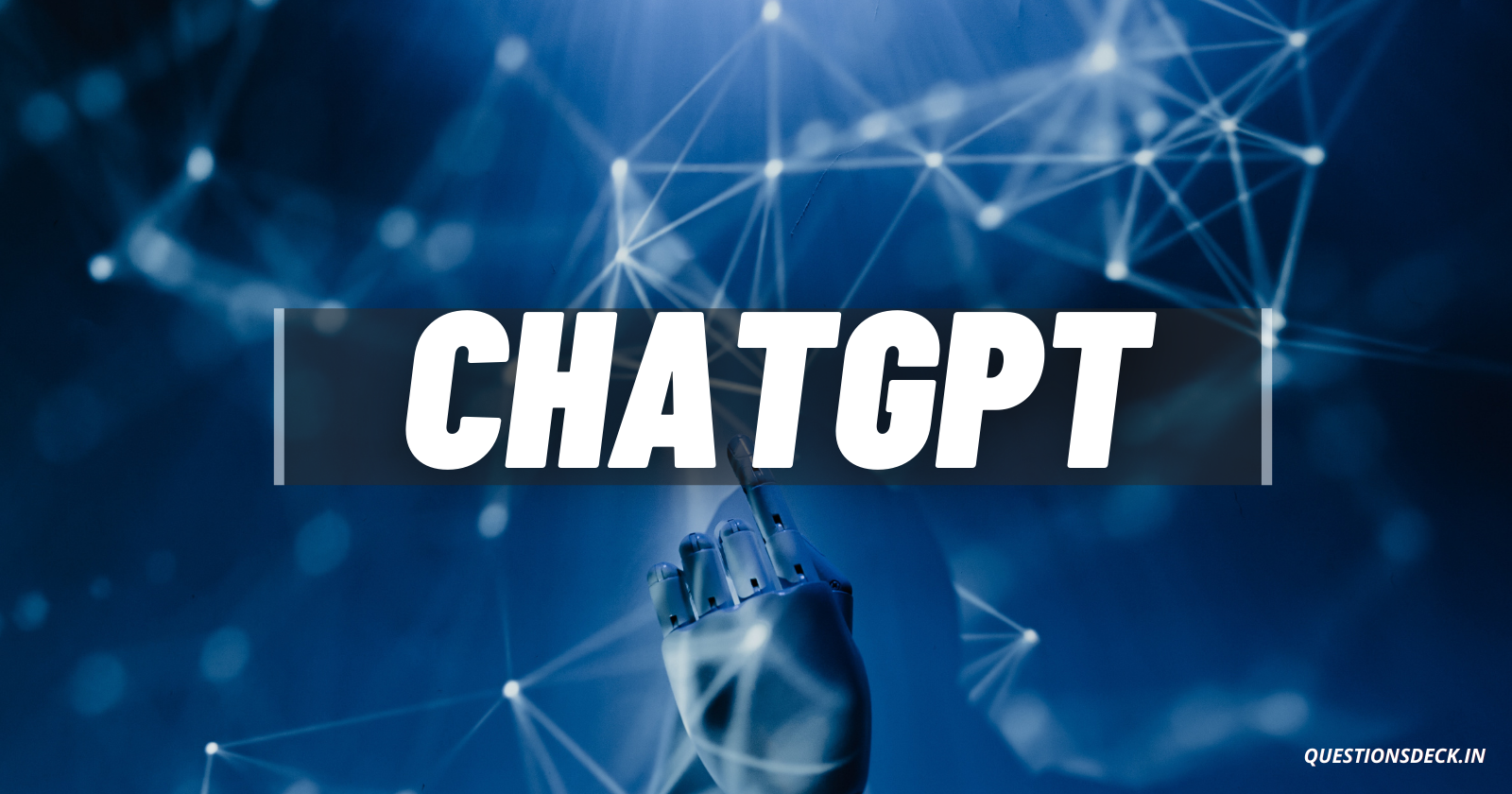What is ChatGPT ?
ChatGPT is a large language model developed by OpenAI, a leading research institute in artificial intelligence. It is a deep learning model that is trained on a massive amount of text data, allowing it to generate human-like text.
It is a variant of the GPT (Generative Pre-trained Transformer) model, which was first introduced in 2018. It uses a transformer architecture, which is a type of neural network that is well-suited for natural language processing tasks. The model is pre-trained on a massive dataset of text, allowing it to understand and generate human-like text.
It can be fine-tuned for a variety of natural language processing tasks such as language translation, text summarization, text completion, and question answering. It can also be used to generate text, such as writing essays, stories, and articles.
With its ability to generate human-like text, ChatGPT has the potential to revolutionize the way we interact with machines and pave the way for more advanced natural language processing applications.
How ChatGPT works: Understanding the technology behind it

ChatGPT is a deep learning model that is trained on a massive amount of text data. It uses a transformer architecture, which is a type of neural network that is well-suited for natural language processing tasks.
The model is trained using a technique called unsupervised learning, which means that it learns patterns and relationships in the data without being provided with explicit labels or outcomes. The model is pre-trained on a massive dataset of text, allowing it to understand and generate human-like text.
The pre-training process involves feeding the model with a large amount of text data and training it to predict the next word in a sentence, given the previous words. This process allows the model to learn the structure and patterns of the language.
Once the model is pre-trained, it can be fine-tuned for a specific task such as language translation, text summarization, text completion, and question answering. Fine-tuning involves training the model on a smaller dataset that is specific to the task at hand. This allows the model to adapt to the specific task and improve its performance.
In summary, ChatGPT is a deep learning model that uses a transformer architecture and is trained on a massive amount of text data using unsupervised learning. Once pre-trained, it can be fine-tuned for specific natural language processing tasks, allowing it to understand and generate human-like text.
Applications : From language translation to text generation
ChatGPT has a wide range of applications in natural language processing, some of which include:
- Language Translation: ChatGPT can be fine-tuned to translate text from one language to another. It can understand the context and structure of the language, which makes it more accurate than traditional machine translation methods.
- Text Summarization: ChatGPT can be used to summarize text by identifying the main ideas and condensing them into a shorter version. This can be useful for quickly getting the key information from a long article or document.
- Text Completion: ChatGPT can be used to complete sentences or paragraphs, making it useful for writing and content creation. It can also be used to generate responses in a conversation, making it useful for chatbot applications.
- Question Answering: ChatGPT can be fine-tuned to answer questions by understanding the context and structure of the language. This makes it useful for creating virtual assistants and search engines.
- Text Generation: ChatGPT can be used to generate text, such as writing essays, stories, and articles. It can also be used to generate creative text, such as poetry and song lyrics.
- Language Modelling: ChatGPT can be used to generate human-like text, making it useful for creating realistic dialogue in video games, chatbots, and virtual assistants.
In summary, ChatGPT can be used for a wide range of natural language processing tasks such as language translation, text summarization, text completion, question answering and text generation. It can also be used for language modeling and speech recognition, etc.
Training and Development: How it learns and improves

ChatGPT is trained and developed using unsupervised learning, which means that it learns patterns and relationships in the data without being provided with explicit labels or outcomes. The model is pre-trained on a massive dataset of text, allowing it to understand and generate human-like text.
The pre-training process involves feeding the model with a large amount of text data and training it to predict the next word in a sentence, given the previous words. This process allows the model to learn the structure and patterns of the language.
Once the model is pre-trained, it can be fine-tuned for a specific task such as language translation, text summarization, text completion, and question answering. Fine-tuning involves training the model on a smaller dataset that is specific to the task at hand. This allows the model to adapt to the specific task and improve its performance.
The more data the model is trained on, the better it becomes at understanding and generating human-like text. The model can also be updated with new data and fine-tuned for new tasks, allowing it to continually learn and improve.
Additionally, there are different versions of ChatGPT models, such as ChatGPT-2 and ChatGPT-3, and these models have been trained with larger datasets than previous models which make them even more proficient.
In summary, ChatGPT is trained and developed using unsupervised learning on a massive dataset of text. The model can be fine-tuned for specific tasks and continually learn and improve by being updated with new data and being fine-tuned for new tasks. Also, different versions of ChatGPT models are trained with larger datasets, making them even more proficient.
Comparison with other Language Models: How ChatGPT stands out
ChatGPT is a large language model developed by OpenAI and stands out in comparison to other language models in several ways:
- Pre-training: It is pre-trained on a massive dataset of text, allowing it to understand and generate human-like text. This makes it more versatile and accurate than other language models that are not pre-trained.
- Fine-tuning: It can be fine-tuned for a variety of natural language processing tasks such as language translation, text summarization, text completion, and question answering. This makes it more adaptable to different tasks than other language models.
- Versions: This ai has different versions, such as ChatGPT-2 and ChatGPT-3, which have been trained with larger datasets than previous models, making them even more proficient.
- OpenAI’s platform: ChatGPT is part of OpenAI’s platform, which provides an easy-to-use API, making it accessible to developers and researchers. This allows for a wider range of applications and faster experimentation compared to other language models.
- Performance: It has demonstrated state-of-the-art performance on a variety of language tasks such as text generation, language translation and question answering.
In comparison to other language models, ChatGPT stands out for its pre-training on a massive dataset of text, its ability to be fine-tuned for a variety of tasks, the different versions available and the easy-to-use API provided by OpenAI. Its performance on different language tasks is also a standout feature.
Limitations and Challenges of ChatGPT: Current and future research
ChatGPT, like any other language model, has its limitations and challenges. Some of the current limitations and challenges include:
- Bias: Like other language models, ChatGPT can also perpetuate biases present in the data it was trained on. This can lead to unfair or inaccurate predictions and generation.
- Lack of understanding of context: ChatGPT, like other language models, lacks an understanding of the real-world context and can generate text that is inconsistent with reality or is factually incorrect.
- Lack of creativity: ChatGPT can generate human-like text but it lacks creativity and originality. It can only generate text based on the patterns and structures it has learned from the training data.
- Lack of commonsense: ChatGPT lacks the ability to understand and reason about the world like humans do, also known as commonsense reasoning.
- Privacy and security: As the model is trained on a large amount of text data, there are concerns about the privacy and security of the data used to train it.
- Explainability: As the model is deep learning based, it can be difficult to understand the reasoning behind its predictions and generation.
Future research in language models will aim to address these limitations and challenges, such as developing methods to reduce bias, improve understanding of context, and increase creativity and commonsense reasoning. Additionally, Researchers are also working on developing techniques to improve the explainability of the models.
In summary, ChatGPT ai , like any other language model, has its limitations and challenges, such as bias, lack of understanding of context, lack of creativity, lack of commonsense, privacy and security and lack of explainability. Future research will aim to address these limitations and challenges to improve the performance and capabilities of language models like ChatGPT.
Conclusion: The Future of Natural Language Processing with ChatGPT
In conclusion, ChatGPT is a large language model developed by OpenAI that has the potential to revolutionize natural language processing. Its ability to understand and generate human-like text, as well as its ability to be fine-tuned for a variety of natural language processing tasks, makes it a versatile and powerful tool for various applications.
The different versions of ChatGPT models that have been trained with larger datasets than previous models, make them even more proficient. OpenAI’s easy-to-use API also makes it accessible to developers and researchers, allowing for a wider range of applications and faster experimentation.
However, like any other language model, ChatGPT has its limitations and challenges, such as bias, lack of understanding of context, lack of creativity, lack of commonsense, privacy and security and lack of explainability. Future research will aim to address these limitations and challenges to improve the performance and capabilities of language models like ChatGPT.
Overall, ChatGPT represents a major step forward in natural language processing and has the potential to open up new possibilities for how we interact with machines. The future of natural language processing with ChatGPT is promising and will likely lead to more advanced and sophisticated applications.

